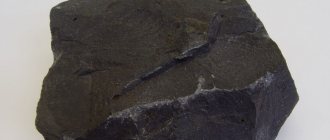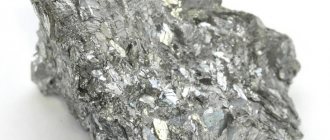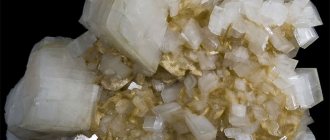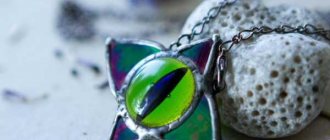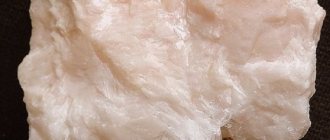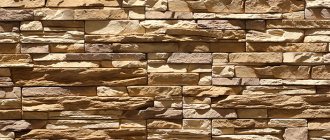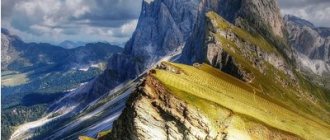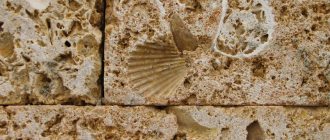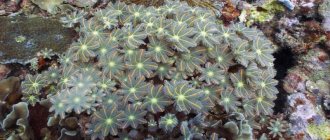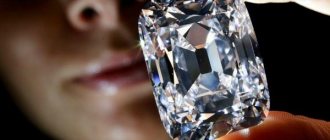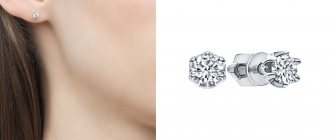Disadvantages of shell rock
There are not many of them at all, and they can be adjusted:
The stone requires careful handling, and its transportation requires caution and certain transportation rules. If you don't handle shell rock carefully, it tends to quickly turn into a broken stone pile. Shell rock cannot boast of high load-bearing capacity
During the construction of a house of several floors, the problem is solved by installing armours under the floor slabs. But perhaps the most significant disadvantage of the mineral is its heterogeneous structure. Different layers of rock from the same quarry differ from each other in the density and structure of the stone. Therefore, when buying shell rock, you need to be extremely careful, selecting a batch of minerals with the same characteristics. Why is this so important? The heterogeneous structure of shell rock often hides many through and open pores. They significantly reduce the heat-retaining properties of the structure - no house would be happy with such a wall.
Chemical composition
The shell shell composition includes:
- Calcium . From a chemical point of view, shell rock is almost 100 percent calcium carbonate. The remaining elements are present in small quantities.
- Iodine
- Silicon
- Carbon
The composition is constant and does not depend on the geography of the deposit. Deposits of this mineral have been found and are being developed in Azerbaijan, Moldova, Odessa and Donetsk regions, Kazakhstan and Crimea.
How to build a fence from shell rock
Fences made of shell rock have been built since ancient times. Today, this type of fencing remains popular, although the market is overflowing with modern building materials for creating fencing. Due to its low cost, ease of installation, as well as the possibility of various finishes, shell rock is readily purchased for the construction of a fence. Therefore, the question very often arises, how to build a fence from shell rock with your own hands?
What is shell rock?
Characteristic
Shell rock is a porous material, which consists of fragments of shells that have been compacted over hundreds and thousands of years. This material contains about 100% calcium carbonate, as well as iodine and salt, which has a beneficial effect on human health. Of course, such environmentally friendly material cannot but interest the owners of private plots. It is worth noting that installing such a fence does not require any special skill, but it does require a lot of time. Porous shell rock actively absorbs moisture, so the fence must be plastered or lined with another material, as shown in the photo. The blocks can be impregnated with a water repellent immediately before installation.
There are two types of shell rock masonry: on a wide part or on an edge, as shown in the photo. You will choose depending on how thick you want the fence. Typically, experts advise using a wide surface of the stone, as this guarantees good stability.
Advantages
- With good care, the service life is unlimited. The stability of the fence mainly depends on the quality of the prepared solution,
- Natural material – environmentally friendly. It will not cause harm to humans or nature,
- Large selection of stone,
- You can install the fence yourself,
- The material is not subject to combustion,
- A fence made of shell rock will look good against the background of any landscape, and will also become a decoration of your site.
If you have decided to build a fence from shell rock, you should know that this process is long and quite labor-intensive. And it must be approached with full responsibility.
Construction
Fence construction technology:
- we mark the fence,
- pouring the foundation,
- building a fence.
First of all, we mark the line of the future fence. Then we measure the length and calculate how many blocks need to be purchased. When calculating, do not forget to take into account the intended height of the fence.
We must lay a strong foundation for the fence, regardless of the type of material from which the fence will be built. We make a strip base with the addition of metal rods, as shown in the photo. In addition, it is necessary to carry out waterproofing. After the solution has completely hardened, formwork for the pillars is created. Then we install it on the foundation and secure it. Now you can start laying out the blocks. First, prepare all the necessary tools for work:
- Master OK,
- solution trough,
- plumb line,
- building level,
- rubber mallet.
It is worth noting that when constructing a fence made of shell rock, you need to be especially careful about the upholstery of the corners. According to experts, the strength of the fence, as well as its aesthetic appearance, depends on this. If you have never dealt with masonry before, be sure to use a protractor with which you can align the corners, as shown in the photo.
After completing the creation of the fence, it is advisable to sew the seams. This will give the fence an attractive appearance. To do this, we run a spatula along the seam, deepening it by 1.5 centimeters, as shown in the photo.
Due to the fact that shell rock is a natural material, insects can grow in it, and green mold can also appear on its surface. To protect the fence from the external environment, it is necessary to treat it with a special compound. Shell rock is large-porous and fine-porous, as shown in the photo. Also, this breed has different shades. It all depends on where the material is formed. Depending on the conditions in which this rock was found, you can find shell rock in pastel colors, white and gray shades.
Let's sum it up
If you have a great desire to have a shell rock fence, you can even build it with your own hands. The fence will be a beautiful addition to the design of your private plot. In addition, a solid fence will protect you from unwanted glances and strangers entering the territory. I would like to add that shell rock is one of the materials that has radiation protection properties.
Calculation of building a garage from a shell: calculator
How much stone will be needed to build a garage? Let's make calculations taking into account that the shell stone has the following size: 390 x 190 x 190 mm.
Typically, a garage is built with one block with a wall thickness of 38 cm. That is, the stone is laid lengthwise. In this case, for one square meter it is necessary to take about 30 shell rock blocks without taking into account the seams (1 / (0.18 * 0.38) * 2 = 29.2 pcs.
Let's do the math with an example. Let's say you need to build a standard garage with minimum wall dimensions: 3 by 6 meters. The height of the walls is 2.2 meters. The perimeter of the outer walls of the garage is 18 meters. Therefore, the wall area is 39.6 m2. Let's subtract the size of the gate from this figure. Let's say they are 5 m2. We multiply the resulting 34.6 by 30. We get 1038 pieces of shell rock for building a garage.
If it is necessary to erect partitions to separate the utility unit, then the calculation is carried out in almost the same way. With the difference that half of the block is taken - 18 cm. The required number of shells per square will be 15.
How does limestone form?
Living marine organisms, large and small, are very important in the formation of limestone. Developing in the depths of the sea in huge quantities, these marine inhabitants multiply incredibly quickly, but die just as quickly
During their existence, microorganisms manage to extract enough lime from the water in order to equip their body with reliable protection in the form of shells or various shells. Subsequently, the skeletons of dead microorganisms lie on the seabed in entire layers.
Over time, these layers are pressed by the water mass, become strong and eventually turn into stone, the main component of which is calcite. As a result, the amount of calcium carbonate is 60% of the total mass of limestone. The rest consists of carbon dioxide and minor clay impurities. It is the impurities that color limestone in different colors.
Description of the stone
Shell rock is a stone formed by the mineral remains of shells and shells of sea creatures. The age of the rock is more than 500 million years. Natural stone has a milky white or yellowish color and a porous surface. In nature it occurs in huge underground layers.
Varieties and brands of mineral
Limestone shell rock mostly consists of lime. Its varieties are determined by shape and impurities:
- oolitic shell rock consists of small spherical particles, reminiscent of fish eggs;
- travertine – contains sedimentary calcite, has a large-porous structure;
- yellow – has no impurities;
- white – high in calcium;
- pink – with an admixture of iron;
- meotis - the pores are arranged in the correct order, reminiscent of a honeycomb.
In construction, several grades of the mineral are distinguished. They differ in pore size: M-15, M-25, M-35. The number in this case means strength. The smaller the pores, the stronger the stone. Brand M-35 has the highest mechanical strength.
The amount of lime in the rock composition also matters. If the rock contains a lot of sand and little lime, it will be brittle and friable. The ideal ratio is 65% lime, 35% sand.
Watch a video review about the stone:
Composition and main characteristics of the material
Shell rock is limestone consisting of calcium salts. Moreover, regardless of the place of extraction, the composition remains approximately the same: calcium carbonate - 52.06-55.66%, magnesium oxide - 0.19-0.71%, carbon dioxide - 41.16-43.62%. Under the influence of acidic water, the calcium contained in the shells decomposes, releasing carbon dioxide. This determines the presence of pores in the structure of shell rock and the emergence of mineral springs. The main color is white-yellow, light yellow. Depending on the presence of impurities, the color may be different: iron gives pink shades to shell rock, copper – blue, coal – from gray to black.
Due to the fact that shell rock was formed in places of former seas and from the remains of marine animals, it releases vapors of iodine and sea salt and has good antibacterial properties. In a room decorated with this material, a specific composition of air appears, which strengthens the immune system and improves overall health. This especially helps people with cardiovascular diseases and those who have problems with the upper respiratory tract and the thyroid gland. Many resorts around the world are famous for their shell rock beaches with healing air.
Shell rock is a natural stone, therefore it is an environmentally friendly material. Compared to others, it has a neutral radiation background - 13 μg/h, with a minimum acceptable level of 25 μg/h. At the same time, it perfectly protects against dirty air, radiation and other harmful radiation by 100%. This is the only material capable of this.
Another very important advantage over other building materials is that mice and rats do not like a house made of shell rock. For a country house this is a significant indicator
The presence of pores is the reason for the low thermal conductivity of shell rock - 0.2-0.6 W/m-C°, while for brick it is 0.55-0.64, more than two times more. The situation is the same with sound insulation. Therefore, the use of this material eliminates the need to additionally insulate and protect the walls of the house from noise, which provides significant savings in construction. In addition, shell rock has very high frost resistance - up to 70 cycles, so you don’t have to worry about the integrity of the exterior decoration of the walls of the house, unless you go to change it yourself. Shell rock is very inert, therefore it does not react with other building materials, therefore, it will not collapse itself and will not subject other substances to deformation.
Based on their density, there are three types of shell rock:
M15 is the loosest, with large pores, and very loose in appearance. It comes in different colors - from white to brown, but most often yellow, for which it received the nickname “yellow”. The yellowish tint is given by the presence of sand impurities, which have a higher thermal conductivity compared to the shell rock itself. Therefore, this brand is the coldest among other brands. When hitting a hard surface, an M15 block breaks into several parts. In terms of weight, these blocks are the lightest (8-12 kg), so their surface may be damaged during loading and unloading operations. Subsequently, in order to level the surface, a large amount of plastering work may be required. Despite this, it is successfully used in the construction of garages, outbuildings, fences, bathhouses, and upper floors.
M25 is a shell rock with medium density and porosity. The main color is light yellow, sand. If dropped, it rarely breaks in half, and even less often into three parts. The most popular brand in construction, as it is superior in strength to brick, gas and foam concrete. Widely used for the construction of two-three-story houses. In frame and panel construction, interior partitions are made from this brand of shell rock. Block weight – 14-17 kg.
M35 is the densest and most durable grade of stone and has the lowest porosity. The color is almost white, yellow-white. The heaviest of all brands (22-25 kg), therefore ideal for laying foundations, basements, and ground floors. White shell rock is stronger than yellow shell rock.
Advantages and disadvantages
The advantages of using Crimean shell limestone are undeniable:
- under the influence of oxygen, shell rock does not oxidize and does not react with any other substances; it is classified as an inert substance;
- does not melt, does not ignite under the influence of elevated temperatures, does not emit toxic fumes;
- due to the presence of useful elements in the chemical structure, it creates a healing microclimate, saturates the air with ionic particles and disinfects it;
- processed with the most standard tools, thanks to which the blocks can be given different shapes;
- is highly resistant to adverse natural factors;
- characterized by high strength;
- the pores provide high heat and sound insulation, and in addition, release condensation from the room to the outside;
- the material does not transmit radiation;
- has a unique texture, available in more than 10 natural colors.
Due to its high performance characteristics, shell rock from the Saki quarry is often used for the construction of buildings; it is widely used for finishing all kinds of structures.
However, there are some subtleties and some limitations that you need to be aware of.
- Shell rock has a relatively low load-bearing capacity, so it is most often used in low-rise construction.
- The material does not hold fasteners firmly enough, especially M15 blocks. To cope with this problem, you need to use only the most modern fasteners.
- Shell stone blocks do not have a standard geometry, since stone extraction does not always result in smooth shapes and exact dimensions - deviations of a couple of centimeters are allowed here.
- High water absorption. To get rid of this drawback, the shell wall material must be properly protected from the outside, treated with special water-repellent impregnations, insulated and plastered. Before moving on to the interior decoration of the shell rock building, it is necessary to perform insulation and complete finishing of the facade. If this step is neglected, in winter homeowners will have to deal with indoor dampness and increased heating costs.
Shell rock: composition and types
Shell rock is not a “full-fledged” stone; it is a natural fossil, although in many sources it appears as a type of natural stone. The material was formed from the remains of marine inhabitants that existed in ancient times.
What does it consist of?
Shell rock is most similar in composition to limestone. He has:
- calcium carbonate, it occupies from 52 to 56%;
- carbon dioxide, which gives the stone porosity (40-60%);
- magnesium oxide (1-2%), due to which the shell rock has a sandy color.
The different shades of material from different deposits are explained by different impurities - other fossils characteristic of a particular region. For example, coal “gives” shell rock a gray or black color, iron - pink, copper - bluish or blue.
Varieties of shell rock
The strength of shell rock also varies. It depends only on the percentage of lime and sand. If there is more of the latter, then the material will be more fragile. Shell rock from each deposit has its own unique composition due to different percentages of the main components.
Stamps
There are three main brands that are popular in construction: M15, M25, M35. M19 is practically not used due to its friability.
- M15. This is the most porous type, containing the maximum amount of sand, and therefore a small percentage of lime. Its disadvantage is fragility: when falling from a height, such a stone is destroyed. M15 is characterized by a light yellow color and lightness. This shell rock is suitable for the construction of fences and small utility buildings with 1 floor.
- M25. This is the most suitable material for the job. There are fewer pores in it, so the density is higher. Shell rock of the M25 grade is capable of maintaining its structure when dropped. This variety has a yellow-gray color. It is used in the construction of load-bearing structures of buildings with 1-2 floors, as well as partitions in multi-storey buildings. The maximum allowed number of floors is 5.
- M35. This material has a minimum number of air cells, so it is durable and dense. When falling, such a stone does not split, remaining unharmed. Thanks to these qualities, the M35, unlike other types, has significant weight. It is chosen for the construction of load-bearing walls, for the construction of foundations and plinths. Due to its severity, it is rarely used in the construction of multi-story buildings.
There is another brand - M20, it is sometimes used for the construction of one-story houses and interior partitions and fences. This shell rock is denser than M15, but the sand content in it is lower than in M25. The color of the stone is yellow.
Block weight
At any stage of construction, when choosing materials, attention is paid to their weight. For shell rock blocks it differs depending on the brand:
- from 15.4 to 18.5 kg - for M15;
- 23.3 - 27.5 kg - for M25;
- from 29.3 to 35.1 - for M35.
Decorating a house with shell rock, both outside and inside, involves the use of low-porosity grades - M25 or M35. It is better to take those materials that have a higher percentage of sand. In this case, after cladding, the shell rock can be protected without any problems with facade varnish, which can become an obstacle to moisture.
Requirements for the foundation for a shell rock house
Shell rock has a lot of weight, despite the pores in it. Accordingly, the foundation must be strong. You can use monolithic reinforced concrete tape. Limestone itself is not suitable for foundations due to its hygroscopicity. However, it is possible to build a base from recrystallized shell rock. Its density is high, the material practically does not absorb moisture, but it is difficult to process. It is almost impossible to cut or break.
When installing the formwork, you need to take into account that the base must be higher than 40 cm. In addition, high-quality waterproofing of the foundation is necessary, the shell rock must be protected from constant moisture.
Features of masonry
Having talked about the pros and cons of a house made of shell rock, you need to consider the features of constructing walls from this material. When constructing a one-story house covered with wooden beams, reinforcement of the masonry is not required. If the building is built on two floors and covered with reinforced concrete panels, then a reinforced concrete belt is poured over the fragile shell rock.
Laying shell rock is not fundamentally different from working with other types of wall blocks. The higher labor intensity is explained, as we have already said, by the variation in the sizes of individual blocks. To level the row in height, it is necessary to lay a thick layer of mortar (2-3 cm).
Recommended composition of masonry mixture:
- cement grade 500 - 1 bucket;
- sand - 4 buckets;
- water - 1 bucket.
To level a row of blocks in height, a highly plastic solution is required. To prepare it, a plasticizer is added to the initial mixture. Its approximate consumption is 0.5 kg per cubic meter of solution.
The construction of walls begins from the corners. Having leveled the corner stones using a level vertically and horizontally, a beacon cord is pulled between them and ordinary blocks are placed.
The construction of load-bearing walls of residential buildings is carried out with a thickness of one and a half blocks (58 cm) or 1 block (38 cm). In the first case, the wall is not additionally insulated, but only plastered. Internal partitions, garages and outbuildings are erected in ½ block (18 cm).
It is recommended to finish walls made of shell rock using the “ventilated facade” system: sheathing + mineral wool slab + siding.
A good option is masonry “two miles away”. The internal load-bearing part of the wall is built from shell rock, and the external part from face brick. During the laying process, ecowool is poured into the resulting well or semi-rigid slabs of mineral wool are installed. The brick cladding is connected to the inner wall with plastic anchors.
https://youtube.com/watch?v=mLlCja9j2Zc
How many blocks do you need?
The dimensions of the stone on the construction market may deviate by 1-2 cm. However, the standard dimensions of a shell rock block are 0.18 * 0.18 * 0.38 m. To build one square meter of wall in one stone, about 0.4 m is needed depending on the the width of the seam with mortar is 25-30 blocks. If the wall is half a block of 0.2 m, then you will need 17-18 pieces. By the way, 1 unit of shell replaces approximately 8 bricks. The width of 1 block is quite enough for the Crimean weather, but a wall of less thickness needs to be insulated along the facade.
Knowing the width, height, and length of the house, you need to calculate the area of the house by subtracting the area of the holes in the walls - these are windows and doorways. Then multiply the resulting number by 25 or 18 pieces. As a result, you will receive the number of shell stone blocks that will be needed when building a house.
Let's look at an example. Let's calculate the number of shells for a 1-storey building with walls 10*10 m thick and 0.38 m thick. We take the height of the walls to be 3 m. So, the surface area of all walls will be equal to 3*(10+10+10+10) = 120 sq m Let's take the area of the holes in the walls to be 10 sq. m. This means that the value we need is 120-10 = 110 sq. m. We multiply it by 25 blocks. We get 2750 pieces. This is the required amount of stone.
In the same way we calculate the amount of shell rock for the internal partitions.
Disadvantages of shell rock and how they can be corrected
Shell rock, having its advantages, at the same time is not an ideal building material. It has a serious drawback - it is heterogeneity. In the quarries for its extraction there are different layers of rock that do not have the same porosity. In this regard, there is a risk of obtaining a material with different characteristics, especially different thermal conductivity. This indicator influenced its lack of availability in hardware stores. However, this is not a reason to abandon it as a building material. You can always choose from the offered assortment blocks with equal indicators; you just need to know how to do this. Mostly shell rock is traded by specialized companies. They also deliver the material to the work site. It is impossible to find a supplier of uniform shell rock, since this problem is common to all companies selling shell rock materials.
The negative qualities of the heterogeneity of the block lie in through pores, which causes a sharp decrease in thermal conductivity.
The erected wall of such material is blown through. To eliminate this drawback, two options can be used. Using the first one, we select high-quality shell rock. We inspect the material for the presence of through pores and determine the weight of the block. A stone that meets normal characteristics must weigh more than 16 kg with a dense structure and medium-sized pores. Good suppliers sort the material themselves and provide a quality certificate for the product. But you should still check the blocks. A block of first grade shell rock, grade M35, does not split if struck on a hard surface. The M25 block should not split into more than three parts with the same impact. The correct shape of the block with the same dimensions, high density and uniform structure indicate the quality of the product. Due to its natural porosity, shell rock has a high degree of moisture absorption. Therefore, the walls should be waterproofed by covering them with a special solution. Building facades finished with shell rock and located in areas of heavy traffic should be treated with oil-hydrophobic agents.
Biological and chemical compounds can be used to protect shell rock
designed for this purpose.
The second option is to eliminate the consequences of material heterogeneity by erecting an external barrier, finishing with plaster with vapor-permeable properties or making a ventilated façade. You can insulate the main walls using thermal insulation with vapor-permeable properties and then finish the facade of any type (“wet” or “ventilated”). A ventilated wooden facade is one of the advanced and environmentally friendly methods used to protect walls built from shell rock. During construction, load-bearing wooden beams are pre-installed into the walls. On which the sheathing of planks is subsequently attached, leaving a gap for ventilation.
Where is it used?
Shell rock from Crimea has found application in the construction industry, and it is not difficult to calculate the required material consumption.
A standard block has dimensions of approximately 18x18x38, each square meter of surface will require 30 standard modules when laying one brick, when laying half a brick, only 18 blocks will be needed. For the construction of low houses in the middle climate zone, the width of the walls of one block will be sufficient. When installing a half-brick wall, the building will require additional insulation.
Shell rock walls can withstand all types of floors - steel, reinforced concrete, and wood. But if you want to live in an environmentally friendly home, then preference should be given to wooden beams. But in seismically unfavorable areas it is worth using monolithic reinforced concrete structures.
In the process of construction work, there is often a need for additional processing of limestone, making lintels, laying beams or bandaging elements. Processing limestone is quite simple; all the necessary elements can be cut out with the most ordinary household saw.
Some homeowners leave interior clam shell walls unfinished. This stylistic solution allows us to emphasize the concept of an eco-house and the connection between home and nature.
Watch the video about the benefits of shell rock and building houses from it.
Disadvantages of shell rock and how they can be corrected
Shell rock, having its advantages, at the same time is not an ideal building material. It has a serious drawback - it is heterogeneity. In the quarries for its extraction there are different layers of rock that do not have the same porosity. In this regard, there is a risk of obtaining a material with different characteristics, especially different thermal conductivity. This indicator influenced its lack of availability in hardware stores.
However, this is not a reason to abandon it as a building material. You can always choose from the offered assortment blocks with equal indicators; you just need to know how to do this. Mostly shell rock is traded by specialized companies. They also deliver the material to the work site. It is impossible to find a supplier of uniform shell rock, since this problem is common to all companies selling shell rock materials.
The erected wall of such material is blown through. To eliminate this drawback, two options can be used. Using the first one, we select high-quality shell rock. We inspect the material for the presence of through pores and determine the weight of the block. A stone that meets normal characteristics must weigh more than 16 kg with a dense structure and medium-sized pores.
Good suppliers sort the material themselves and provide a quality certificate for the product. But you should still check the blocks. A block of first grade shell rock, grade M35, does not split if struck on a hard surface.
The M25 block should not split into more than three parts with the same impact. The correct shape of the block with the same dimensions, high density and uniform structure indicate the quality of the product. Due to its natural porosity, shell rock has a high degree of moisture absorption. Therefore, the walls should be waterproofed by covering them with a special solution. Building facades finished with shell rock and located in areas of heavy traffic should be treated with oil-hydrophobic agents.
The second option is to eliminate the consequences of material heterogeneity by erecting an external barrier, finishing with plaster with vapor-permeable properties or making a ventilated façade. You can insulate the main walls using thermal insulation with vapor-permeable properties and then finish the facade of any type (“wet” or “ventilated”).
A ventilated wooden facade is one of the advanced and environmentally friendly methods used to protect walls built from shell rock. During construction, load-bearing wooden beams are pre-installed into the walls. On which the sheathing of planks is subsequently attached, leaving a gap for ventilation.
Construction of a house from shell rock
The durability and reliability of shell rock does not need confirmation. In Crimea, the North Caucasus and even in the cities of Foggy Albion there are structures made of shells - undestroyed! - standing for hundreds, and even a thousand years. The material from a natural conglomerate, calcareous shells of ancient mollusks that lived in the sea millions of years ago, is surprisingly resistant to atmospheric influences, frost, and heat. Frost resistance of dense varieties is about 60 - 80 cycles, thermal conductivity is low, and heat resistance is high. In terms of fire, shell rock is safe and itself serves as a barrier to fire for some time. But we must remember that in the structural “pie” of the walls there will be more than one shell rock, so insulation and finishing materials should be chosen accordingly.
Healing properties of fossils
The healing properties of ammonite have been used by healers since the discovery of the stone. Since it contains only natural substances found in nature, it has a positive effect on health. According to popular belief, it helps well with sleep problems: its properties allow you to get rid of nightmares and insomnia, and improve your mood after waking up. In ancient times, healers used shells as a sedative. Lithotherapists highlight the following healing qualities of ammonite:
- elimination of depression and apathy;
- improving blood composition and restoring normal blood circulation;
- slowing down the aging process;
- relief from chronic fatigue;
- increasing resistance to colds;
- elimination of skin rashes;
- therapy of childhood diseases (measles, scarlet fever, chickenpox, etc.);
- treatment of infertility and improvement of pregnancy.
Due to their ability to harmonize human energy, ammonites are actively used today in China. Applicative applications and stone massage are popular. They stimulate the functioning of body systems and normalize blood flow. During the massage, movements are performed in a spiral, repeating the curls of the fossil.
Shell rock, its advantages and disadvantages
Shell rock is a completely natural stone suitable for building houses. It has a porous limestone base, sedimentary type of formation. It is mainly mined on the Crimean Peninsula. The age of this building material goes back many millions of years and, as a rule, the main deposits are the sites of former reservoirs.
Externally, shell rock looks quite interesting and attractive. The formation of the stone occurred on the site of disappeared seas and oceans, due to the settling of fragments of aquatic microfauna on the bottom sand. After the disappearance of water, the sand, mixed with the remains of sea and coastal crustaceans, crabs and other living creatures, was compacted, covered with binding layers of clay soil, and as a result it was born - our building material called “shell rock”.
The composition of shell rock is entirely limestone, calcium, containing iodine and salt additives. It is these nuances that fill houses built from shell rock with healing, disinfecting properties and create an atmosphere extremely favorable for human health.
The porous structure of shell rock plays the role of a natural filter, guarding unwanted substances and bacteria that can penetrate inside houses built from other materials.
Shell rock is an absolutely neutral composite that combines perfectly with other materials in construction.
As we have already understood, shell rock is an ideal building material from the point of view of ecology and health benefits, but the most important thing about this stone is that it is absolutely impenetrable to any radioactive radiation.
If you were thinking about using shell rock as the main material for building a house, then for the convenience of your choice, we have compiled all the positive characteristics of the stone.
Advantages
- Due to the high porosity of shell rock, which is twenty to sixty percent, this material has unique thermal insulation properties. A house made of this building material will always be warm in winter and cool in summer.
- As we already wrote above, shell rock is an absolutely environmentally friendly and safe material.
- Again, due to the porosity of shell rock, the house will always be dry.
- Shell rock does not rot and does not allow mold to form due to its high content of iodine and salts.
- High degree of sound insulation.
- Low weight as a result of porosity.
- Moderate price compared to other building materials.
- Shell rock is absolutely fireproof. It doesn't burn. The most that happens to it at the epicenter of the fire is that it can begin to crumble.
- There are no rodents or other unwanted guests in the form of cockroaches and bedbugs in a shell rock house.
- The large dimensions of this building material make it possible to build a building as quickly as possible. One block of shell rock is approximately seven to nine standard bricks.
- The porosity of shell rock gives high adhesion, which is very attractive for finishing work.
- High thermal insulation, which is superior in performance to foam concrete and aerated concrete.
- Antibacterial and anti-radiation properties.
And the other side of the coin is the disadvantages of shell rock:
- Heterogeneous composition of stone porosity due to the difference in layers in the deposit.
- Occurring through pores, which can weaken the heat and sound insulation. This can be easily sorted out by checking and weighing each stone. It’s a labor-intensive and time-consuming task, but you want to get the perfect house built from shell rock?
- Shell rock requires coating with special solutions that resist moisture. The outer sides of a shell rock house can be equipped with a ventilating façade.
- Not very dense shell rock may lose the sharpness of its corners a little during transportation, which will require an increase in the amount of mortar during the laying process.
- And the main disadvantage is the relatively low load-bearing capacity. That is why this material is most often used for the construction of low-rise buildings. As a rule, two floors maximum.
If we continue our conversation about the quality and types of shell rock, we cannot help but touch on the markings of the stone. But, before we touch on this topic, you should know that professionals divide shell rock into two groups based on color and density.
The first is white shell rock. It's the densest.
The second group is yellow, which has a lower density.
But it is worth clarifying that the properties of any stone, regardless of the place of formation, are absolutely the same and the more visible the porosity of the shell rock, the stronger it is.
